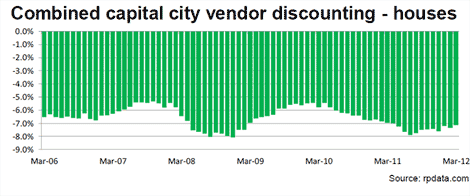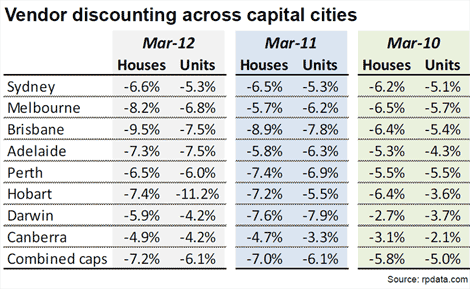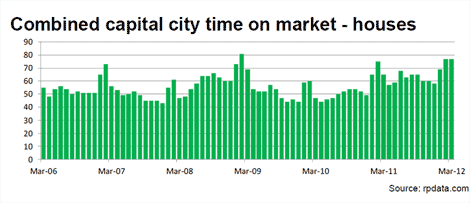Australian property markets becoming more balanced: Cameron Kusher
The level of vendor discounting and the average time on market are important vendor metrics to understand as they provide an insight around selling conditions in the marketplace.
Vendor discounting is simply the difference between the price at which a property is initially listed for sale and the price at which it ultimately sells for.
Time on market, on the other hand, is the difference between the date when a property is first advertised for sale compared to the contract date of a sale.
Both measures are taken across private treaty sales only and are across just those properties that have sold. Given this, it provides a good indication of conditions to those vendors that are focused on successfully selling their home.
As the first graph shows, the level of vendor discounting for houses has been trending slightly lower over recent months.
Across the combined capital cities, vendor discounting is recorded at -7.2% for houses and -7.1% for units. The vendor discounting measure for houses is higher than it has been in recent years while for units it is the same as it was at the same time last year.
Click to enlarge
Across individual capital cities, vendor-discounting levels for houses are lower than at the same time last year in Perth and Darwin but higher elsewhere. Discounting levels for units are the same as last year in Sydney and lower in Brisbane, Perth and Darwin. In Melbourne, the level of vendor discounting is much higher than it was at the same time last year.

The average number of days it takes to sell a house across the capital cities was also trending lower over the second half of 2011.
Typically there is a spike in the time it takes to sell a home early in the year and it has eased by March however, this year’s data is not reflecting these conditions for houses.
The average number of days it takes to sell a house was recorded at 77 days in March 2012 and it was 51 days for a unit. Both measures were higher than the 65 days and 47 days recorded respectively at the same time last year.
Click to enlarge

At an individual capital city level, the average time on market is lower than at the same time last year for houses in Brisbane, Perth and Darwin.
For units, the average time on market is currently lower than 12 months ago in Brisbane, Perth and Darwin. In Sydney, the average time on market is relatively similar to that at the same time last year while in Melbourne it is taking much longer to sell property than it was last year.
Click to enlarge

The improvement in vendor metrics in Brisbane, Perth and Darwin and the weakening conditions in Melbourne are reflective of the overall market conditions across these cities and highlighted by the amount of stock currently available for sale across these cities.
In Brisbane, total listings are just 2.3% higher than a year ago, in Perth they are -6.4% lower, in Darwin they are -16.4% lower and in Melbourne they are 36.1% higher.
The lower levels of discounting and average time on market in Brisbane, Perth and Darwin reflect improving market conditions in those cities. On the other hand, the significant increases in both measures across Melbourne reflect the cooling conditions across that market.
Overall, the elevated volume of stock available for sale reflects the low levels of demand for housing credit. Ongoing weakness across the housing market is likely to result in the average level of vendor discounting and the average time on market remaining at above-average levels.
Although this is likely to be the case, we have in recent months seen the amount of stock available for sale decline and the volume of sales stabilise. This may result in some further improvements in vendor discounting and time on market.
Cameron Kusher is senior research analyst at RP Data.
This article originally appeared on SmartCompany.
